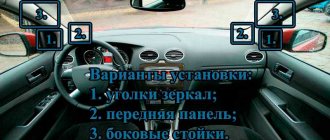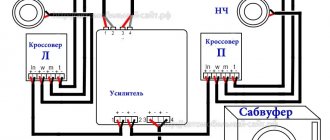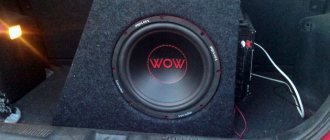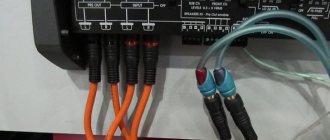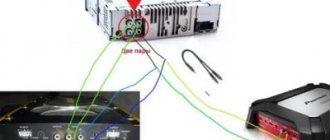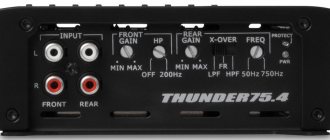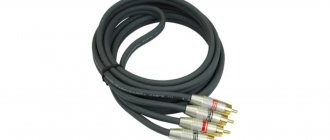Articles
Car radio with rear view camera
A car radio with a rear view camera is very popular and in demand today. Why is probably no secret to many. The fact is that car radios with a rear view camera provide a unique opportunity to automatically connect video recording and display the image on the large screen of the head unit.
Connecting a rear view camera to the head unit
Connecting a rear view camera to a standard factory radio is a rare option (with the exception of the premium segment, where automakers and dealers make good money on additional options), because Most cars equipped with a standard color display are already equipped with a rear view camera from the factory.
If the standard camera breaks down, then everything is simple - order using the spare part number and replace it at the nearest service center or at an official dealer.
To replace a standard camera with a non-standard one, you will need an experienced installer, because... A connector-to-connector installation will not work here - there are a lot of nuances, for example, most standard cameras operate on 6 Volts, and non-standard cameras on 12 Volts. (On old Japanese cars, the standard camera is generally 9-volt, and some non-standard cameras actually work on 3.3 Volt, they just have an adapter built into the wire from 12 to 3.3 Volt). These nuances can confuse some installers during the process of replacing the camera.
If there was no camera from the factory, but you want to install it, then you need to find out if there is a way to connect the camera to your standard radio model. This is usually done using the Internet on specialized forums for the relevant brands and models of cars.
Next, you can find a good technician who can “organize” a standard RCA input for the camera using a soldering iron, if that suits you, or go to the first option, which involves replacing the standard radio with a non-standard one, or use additional solutions for connecting the camera, which are discussed below .
There are cars that are difficult to replace the standard radio, these include many popular cars in top trim levels and almost all premium ones. For such cars there is a solution - a video interface (or transcoder GVIF, RGB, LVDS, etc.), which allows you to display the image from a non-standard camera on the car’s standard display, without losing image quality and standard functionality. It looks something like photo 4.
In addition to the rear view camera, this interface also allows you to display an image from any video source, for example, a TV tuner, or a navigation unit (usually on Android OS, but that’s a different story) on a standard monitor, which is why it usually costs 5 times more cameras - from 5,000 rubles to the limit determined by the greed of the seller (from an official dealer the price can reach up to 50,000 rubles, without installation).
As an example of a car in which it is not so easy to install a rear view camera - modern Nissan Qashqai (J11) and X-Trail (T32), equipped with the Yandex.auto system. In addition to the lack of a standard RCA connector for a rear view camera, standard radios with and without a camera differ in firmware, which is not so easy to find.
This means that the camera, even if connected correctly, will not work until the appropriate firmware is installed on the radio. If you are a confident Internet user and independently found the required firmware, pinout of standard connectors, camera connection diagram, pinned the connectors and connected it, then 2 scenarios are possible. The first is that everything will work as it should. The second is that during the firmware something will go wrong, someone will decide to turn the ignition key, or the car’s battery will run out and the radio will turn into a beautiful, but useless decorative element. Therefore, it is better to turn to professionals.
In our store there are different solutions, for example, a rear view camera for Yandex.Auto, which will work 100%, but you can install it here. We guarantee the functionality of the standard radio after such installation.
Photo 4
By the way, we have the necessary interfaces and experience in connecting rear view cameras and navigation units to Audi, Mercedes, BMW, Lexus and other premium brands. So, if you haven’t found a suitable radio for your car in our assortment or don’t want to change your original standard device, please contact us.
Selecting a rear view camera for installation
Now let's select the rear view camera. There are many options on the market now (our Navishop store has time-tested models of rear view cameras for various cars). We will try to describe each one.
Conventionally, we can divide the cameras into standard ones, which were installed at the car plant (not at the official dealer) and non-standard ones, installed on the car after leaving the car factory, at the official dealer, at third-party installation tuning studios, or independently.
Everything is clear with the standard ones - they can be found by the spare part number; if you have any difficulties with this, the store managers will help with original spare parts, there are quite a few of them now.
Just keep in mind that to connect such a camera to the standard radio, there may not be standard wiring from the trunk to the radio if your car did not have an original camera. And when connecting such a camera to a non-standard radio, you will need, in addition to wiring to the radio, adapters to standard connectors and a power adapter from 12 to 6 Volts, which I wrote about above.
You also need experience and access to the Internet to find the pinout, diagram and/or necessary adapters; this information is for those who decide to install a rear view camera themselves.
If I have not yet convinced you to install a standard camera, then here is the last argument - it has poor resolution, because... Usually it is intended for output to a standard radio, the display diagonal of which is from 4 to 7 inches; less often, the display on the standard radio has a larger diagonal, but even in these cases, the resolution of the standard camera is inferior to the non-standard one.
Therefore, when connecting a standard camera to a non-standard radio, if the display has become larger, the image becomes blurry. Technically, the image does not lose quality - you see the same picture, with the same resolution, but on a larger display. This is the opposite - it allows you to see the details in the image closer, and when looking at a larger display, it takes less time to “get into” the situation that the camera shows. In practice, many people complain about blurry images. Like, on the standard radio the picture was normal, but here it’s all blurry. Keep this in mind if you plan to install a standard camera, or connect it to a non-standard radio.
Where to install the rear view camera
Non-standard rear view cameras can be divided into three form factors - universal mortise, universal in the license plate frame and in a standard place. There are several options in our Navishop store.
Video: connection instructions
A rearview camera installed on a car with your own hands will help save money on the purchase of equipment and car service services, protect against unexpected collisions and collisions while driving on the road and in the parking lot, and make reversing maneuvers safe. The process of installing a video camera on a car is not difficult and will not take much time. This additional car device will give a sense of security to both novice and experienced drivers.
How to choose, install and connect daytime running lights with your own hands
How to connect a DVR in a car without using a cigarette lighter or wires
Rear view cameras in standard place
First, let's look at cameras for installation in a “regular location”.
By “standard place” we mean either the backlight (for all Korean/Japanese manufacturers, photo 5), or the trunk opening handle (mainly for German cars, photo 6) or in the logo (there are also motorized ones, as in photo 7). Calling these cameras “standard” is not entirely correct, because if there is a place in a car for a standard camera, then this place is not in the license plate light or in the trunk opening handle, but on a special platform, to the right or left of the handle or lampshade, and most of all it is suitable for installing a universal mortise camera, no matter how paradoxical it may sound.
Photo 5
Photo 6
Photo 7
The main disadvantage of cameras in a “standard place” is that it can be difficult to choose the right one for your car (always externally check the shape of your lampshade or trunk release handle with what is offered on the website).
If such a camera breaks, then in return you will have to select the same shape, and here you will be faced with the fact that such a camera may not be available either in the nearest stores or at the person who sold or installed it to you.
Or, as often happens with cameras in the trunk opening handle (they like to install them on Volvo, VW and Skoda), it is not the camera itself that stops working, but the very trunk opening button that is built into the handle.
At a minimum, this situation will waste your precious time searching for exactly the same camera. As a maximum, you will have to put back the standard trunk release handle, or the standard backlight (if they were not lost in the garage, or were not left with the installers) and still install a universal camera, which will be discussed further.
TOP best 2din car radios
Before you go to the store to make a purchase or order a device online, you need to decide on the criteria for choosing a radio. The most significant of them are:
- dimensions;
- screen type;
- availability of connectors;
- additional functions.
It is quite difficult for an ordinary car enthusiast to make a choice, because manufacturers offer a wide selection of models.
Celsior car radio
To make the task easier, the TOP of the best radio tape recorders is compiled. It takes into account several basic parameters of the device, including:
- price;
- quality;
- functionality.
In addition, when compiling the rating, reviews left by satisfied customers are also analyzed.
Universal rear view camera
Universal cameras, as I wrote above, are presented in several main form factors - a license plate frame (photo 8), mortise cameras for a stud with an 8 mm nut (photo 9), or for an 18-21 mm cutter like a parking sensor (photo 10) .
Photo 8
Photo 9
Photo 10
With the camera in the license plate frame, everything is clear - few people like it in appearance, but it performs its function properly, moreover, the camera is usually located exactly in the middle of the car (if the license plate area of the car is in the middle) and in most cases it can be adjusted so that the bumper was visible (or not visible).
Universal cameras look better - in most cases they cannot be distinguished from factory ones, but they are usually installed a little to the left or to the right of the center of the trunk, and its angle cannot be adjusted. This drawback is usually offset by a wide camera viewing angle and built-in parking lines (we'll talk about them below).
Someone will now object and remember adjustable cameras “on legs” (photo 11), but we will not consider them here, because Such options do not look very aesthetically pleasing, and the bracket on which they are mounted, due to vibrations and an aggressive external environment, quickly remains without paint and becomes covered with rust, and then completely falls off.
Photo 11
There are rare versions of chambers with a built-in washer, or rather with a nozzle - the washer reservoir and pump are usually used those that are already in the car.
This is a useful thing, but before you decide to install this option, think about whether the potential costs outweigh the need to wipe the lens of a regular camera 1-2 times a week.
Let's assume that you have carefully read all of the above and decided on where the image from the camera will be output, where we will install the camera, and its form factor. All that remains is to choose the camera itself.
What, besides its shape, is worth paying attention to? For technical specifications.
What are the trunk volumes of different cars - comparison of models
- wires should not fray;
- do not allow the wiring to dangle freely;
- for winding and additional protection against abrasion, use high-quality electrical tape;
- If you can, secure the wiring with zip ties;
- It is better to use ties in the area of standard wiring harnesses;
- You can also fix the wires using technical holes on the car body;
- use sealant as needed;
- some wires can be glued to the body and various surfaces;
- The wiring is laid along the thresholds, or behind the trim on the ceiling, that is, from below or from above.
That's sorted out. Even if you have a Chinese or domestic assembled car, this will not prevent you from installing a full-fledged KZV. The main thing is that there is a device where the image itself will be displayed. It could even be a regular Android tablet.
For the system to work properly, you will need:
- Two-wire wiring. It will provide power to the camera itself;
- Two-wire wiring for video communication channel. To display video from the camera on the monitor, wires with an RCA connector are used. These are known to everyone as tulips. The wires on them are not shielded, therefore, if necessary, they are lengthened or cut when it is necessary to pass through difficult areas of the body.
Sometimes, in order for the system to work correctly, special excitation wires come out of the tulips.
This excitation wire serves to activate the multimedia system screen with a positive charge. Thus, the system will automatically switch to displaying video from the KZV.
Excitation wires are not used on all multimedia systems. On some vehicles, switching to KZV in automatic mode is possible using a video communication channel. If your radio does not have such a function, it is disabled or does not work correctly, then you will have to use the button to change the image.
Technical characteristics of rear view cameras
Of the technical characteristics, the key ones for us are (in descending order)
— Resolution, or number of TV lines
— Viewing angle
- Degree of protection
— Photosensitivity
Let's briefly look at each of the parameters.
Permission. It's simple here - the more, the better. The higher the resolution, the clearer the picture will be, the larger the display it can be displayed without blurriness.
But you need to understand that the resolution of the rear view camera is usually less than that of the radio itself. In turn, the resolution on a radio is usually lower than on the same smartphone - now, in 2019, the resolution of non-standard radios with a display aspect ratio of 16:9 is no more than 1024x600 pixels, even with a diagonal of 10 inches. This is due, in addition to savings - the pixel density is quite enough to distinguish a navigation map or video at a distance from the driver to the radio so that the picture does not blur and is clear. You won't find a rear view camera with at least FullHD resolution, because... it's simply pointless until there are radios with such resolution.
At the moment, the resolution of rear view cameras is most often 510x496, 628x582, 656x492, 680x512, 640x480, from 420 to 520 TV lines. There is also one with a resolution of 1280x960, but this is Alpine, costing from 15,000 rubles at retail.
As you can see, even calling these resolutions HD is a stretch.
Viewing angle. The larger it is, the wider the image that the camera will capture. There is one trick here - manufacturers usually indicate not horizontal or vertical viewing angles, but diagonally, that is, from the lower left corner to the upper right. If you measure this way, the angle is always larger than horizontal or vertical. Most manufacturers claim a diagonal viewing angle of 120 to 170 degrees, but this is not always true. Here the issue will be decided by demonstrating the viewing angle of the camera on a stand, or directly in the car, or reviews of people who have already installed it in their car. Sometimes the product description of a camera on the Internet contains a screenshot from the screen of the radio that the camera is connected to, but this is not always worth believing, because Both sellers and camera manufacturers themselves often lie - characteristics can change from batch to batch, often without warning.
Degree of protection. The rear view camera may fail due to frequent visits to the car wash. Now I will explain why this happens. The degree of protection is indicated by the manufacturer in the IPXY format, where X is the degree of protection from dust (can be from 0 to 6), and Y is from moisture (from 0 to 9). All non-standard rear view cameras that are currently sold on our market have a protection level of IP66 or IP67. And if everything is in order with dust protection (6 is the maximum value, it indicates the maximum dust resistance of the product), then with moisture protection everything is not so good.
Camera Protection Standards
IP66 - Protection against jets of water from any direction, 100 liters per minute, at a pressure of 100 kPa, at a distance of 3 meters
IP66K - Protection against jets of water from any direction, 75 liters per minute, at an increased pressure of 1000 kPa, at a distance of 3 meters
IP67 - Protected against immersion in water up to a depth of 1 meter for 30 minutes
IP68 - Protection against immersion in water to a depth of 1 to 3 meters
IP69K - Protection against jets of water at elevated pressure of 8000-10000 kPa, temperature up to 80 degrees and a distance of 1-1.5 mm, 14-16 liters per minute.
Now let's look at the characteristics of a high-pressure washer, for example, let's take the well-known Karcher, the model we will choose is not the most powerful, but not the weakest - K5 Basic 2100 W (car washes usually use more powerful models, but for comparison this one will be enough for us). Let's look at the characteristics - pressure 145 Bar (14500 kPa), capacity 500 liters per hour (8 liters per minute). What can be concluded? With a relatively low productivity, we have clearly excessive pressure, which, if you do not maintain distance when washing, threatens to damage any camera, even if it has maximum protection.
Failure will consist either in a cloudy image (water gets under the lens), or in the banal absence of an image from the camera. This is not a warranty case; you will have to buy a new one for the camera, at your own expense, of course. How to avoid this? Warn the car wash employee not to pour on the camera from a distance of less than 2 meters.
Photosensitivity. Measured in Lux. Conventionally, the lower this indicator, the better. The minimum light sensitivity that I have seen is 0.4 Lux, the maximum is 0.01 Lux, the average value on the market is 0.1 Lux. You must understand that even with a sensitivity of 0.01 Lux, the picture from the camera in the dark will not be visible much better than from a camera with a sensitivity of 0.1 Lux. The difference will be clearly visible only when shooting in pitch darkness, which is not easy to find even in the city at night, besides, no one has canceled the light from the rear lights of the car, they illuminate everything around even in the absence of other light sources. Almost all of the cameras listed above have a version with infrared illumination (photo 12), there are several IR diodes, the light from which is not visible to the human eye, but is visible on video, and sometimes in such a way that it is difficult to see anything else besides this light .
Photo 12
Over time, the diodes begin to fail one by one, and this does not take much time; in most cases, a year is enough. Because of a car wash, such cameras fail much more often than simple cameras, this is due to the location of the diodes - they usually stick out directly from the camera body, around the lens. It is much easier for water to get into the camera along the edge of the LED, through the gaps between the LED and the camera body. When choosing a camera, I do not recommend taking this characteristic into great account - of all those listed above, it is the least important for a camera that is installed to monitor the situation behind the car when moving backwards.

